Alaska Native Theatre Comes of Age
Let us introduce you to Alaska. It’s maybe not the Alaska you’re used to seeing portrayed. The focus isn’t on the beautiful mountain views (though I guarantee the actual views are even better than you’ve seen on any screen). The focus isn’t on the wildlife (though as I write this, there’s a Facebook request I’m tracking for local moose sightings). Alaska is just as dramatic and majestic as you think. Probably more so. But even on the abundant tour ships that land here each summer, the story of Alaska seems to begin when white explorers and settlers showed up. The story of Alaska has often been co-opted to mean the story of gold and oil and the Iditarod and (more recently) Sarah Palin.
The first Alaskans have been telling the real story of the land for thousands of years. They are stories of the creation of those majestic mountains, how the very rivers and plants and creatures came about. They tell the stories of people thriving in climates not meant for the weak. They are stories of the land we love, and the people who love on it. Yet so often, these are not the stories the rest of the world, or often even the rest of Alaska, knows outside of our communities.
This week, we have curated a series that will introduce you to Alaska through a small group of Alaska Native theatre professionals. Through their own journeys in Alaskan theatre, we hope you’ll begin to see Alaska in a different way. Through the stories of those whose people have been here since Raven brought the light, we hope you will not only see Alaska in a different way, but theatre itself.
Gunalcheesh! Quyana!—Vera Starbard, series curator.
The singing begins offstage. A single voice. It’s designed to be noticed, and the chatter of the audience begins to dissipate. This is the only warning the show is about to begin.
The music—powered by percussion of every kind—shatters the remaining conversation and commands attention. And then the chorus of voices joins the song. The dancers enter slowly but purposefully, dressed in elaborately designed regalia that makes them taller, or bigger, or just more noticeable. The clothing is meant to hide the human figure and transform the dancer into a new creature.
Three new dancers enter wearing large, intricate masks—one depicting a white raven, one depicting a sun, one depicting a bear—and seem to move effortlessly under their weight. The masked dancers become the focus of this number. They move, they tease, they gesture with the story being told. And as the narrator gets to the climax—magic! The masks transform in a seemingly impossible way. The white raven opens, turning the character into a black raven; the sun turns into a moon, the bears into stars.
The set itself changes too: stars seem to rain down in downy feathers, light is thrust upon the stage, and the remaining dancers became a wall of black and red. The crowd erupts at the end of the number.
The scene could be the description of a new musical on Broadway. But it isn’t. It’s a performance of my people, the Tlingit people, done in a tribal hall in Juneau, Alaska. The dance and the music, the masks, the sheer production value, have all artfully been perfected over thousands of years. They were passed from one master storyteller to the next, handled with skill and measured in millennia of practice. The performance seen today is the same, or actually less elaborate, than the performance of five hundred years ago.
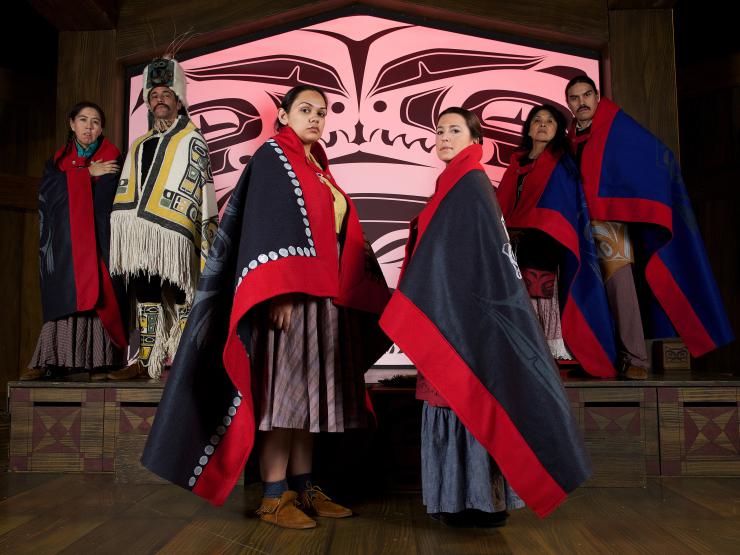
This is the heritage I come from. A heritage with a high value on showmanship and artistic excellence. And yet in my own artistic journey I so often find myself in an educational or defensive mode, one that is common among Alaska Native artists.
“I had no idea your Native culture was so sophisticated!”
I can’t tell you how many times I’ve heard a version of this statement, whether as a comment on our art, politics, social structure, or educational system. I cringe. I sigh. I smile.
“Well, we were living in wood-planked homes while Europeans were walking around on mud floors.”
Okay. I don’t actually say that. I often want to, though. The shock of Alaska Native people being nuanced or educated pre-Western contact is an exhausting perspective to confront.
The idea that we might have an artistic medium akin to Western theatre has become my new thought battle. Yet when production started at Perseverance Theatre in Juneau for the first play I wrote, all we had to do to get an extremely skilled set of “theatre” creators was to approach traditional Tlingit artists. A Tlingit formline painter designed pieces of the set. A traditionally trained Tlingit musician composed the music. The Tlingit actors we hired were already versed in traditional Tlingit oratory style and dance movements.
In my own artistic journey I so often find myself in an educational or defensive mode, one that is common among Alaska Native artists.
Many contributors had never been involved in Western theatre, but they all helped create a stunning piece of “Western” theatre. That the play looked, felt, and sounded different than any other play on Perseverance Theatre’s mainstage was not a product of Western theatre, however. At its core, it was the product of a still-strong culture on display. Not an echo of the past, but a living, breathing, full-throated cry of a culture that is proud, and fierce, and that revels in its artistic feats.
And yet even in our own Native communities, the expertise and genius of the Indigenous artist is shunted for the dominant society’s idea of fine art and sophisticated culture.
Not quite a year ago, one of the most prominent figures of Tlingit arts, scholarship, and heritage, Nora Marks Dauenhauer—who has an enormous body of work—passed away. Part of the statewide grief was seen on social media, through the sharing of poetry, favorite stories, and moments had with her. I pulled out a small publication of hers I had recently purchased, mostly filled with poetry, and thumbed through it. To my surprise, there were plays in it! I had had no idea that Nora was also a playwright.
But even she, a legendary figure in our community, prefaced them with a notation: “Some people don’t consider these plays, but…”
They were her Raven plays, a cycle of stories based on the traditional Tlingit legends of the Raven. Reading them I was both angry and confused. Who said these weren’t plays? Their structure may not fit a Final Draft template, but neither do Shakespeare’s. They were funny, full of imagery, had colorful characters—everything you would want in a good play. Yet even Nora felt the need to defend her art as “real” art.
At the same time, I wasn’t surprised. The downgrading of Indigenous art from actual art to just crafts, souvenirs, novelties, stereotypes, and reimagined purpose is not unique to the Tlingit culture. Nor, for that matter, is cultural appropriation. In my own artistic journey, I have combatted again and again the idea that Native art is simplistic. I can agree that many, many forms of art from Indigenous cultures don’t match a Western norm. But that’s only a problem if we see Western ideas as the pinnacle of what art can be. And certainly Western arts don’t have the monopoly on complexity and nuance.
And yet that is a traumatic part of our history, too. These powerful stories and dances were outlawed—up until the late twentieth century. My grandmother attended school where she was required to “not speak Indian,” much less share the stories of her heritage. To become a citizen of the United States, our great-grandparents had to destroy—often by burning—intricate and valuable works of artistic expertise. They signed contracts (witnessed by a white person or it didn’t count) vowing to never create these works of obvious savagery.
Done under the guise of civilizing, the colonizers understood acutely how to truly destroy a people. And eliminating our art, our creativity, was key. Individual expression was seen as a dangerous thing, but even more so was the creativity fostered and honed and perfected by ancestors, reaching back to the beginning of the land. The creativity of a community with a strong sense of identity. The creativity that a community uses to self-identify, to pass on stories, to share messages with others.
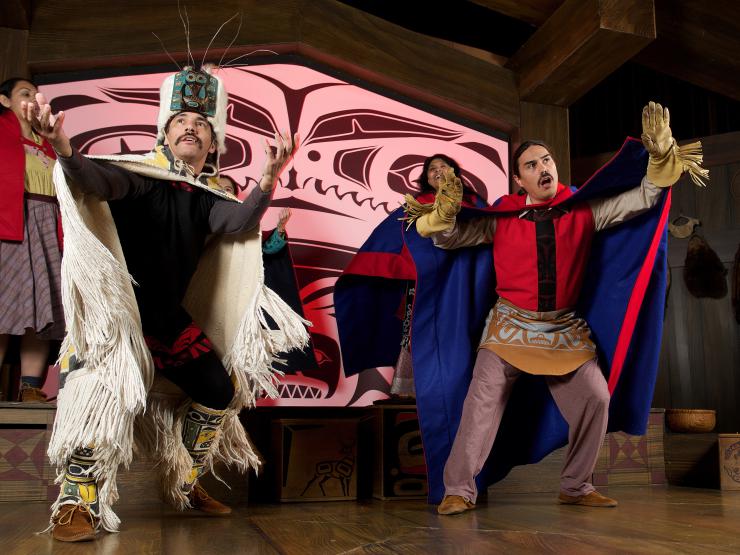
In my culture, art is often used as overt political expression and, done incorrectly, could spark wars. Yes, the colonizers knew what they were doing when they began to outlaw our art.
The good news? They were not successful. We have not come through the experience without devastating loss of life and culture and language and land. But we have come through it. We are coming through it. The artistic celebrations around the state are still the largest gatherings of Native people every year. Artistic expression is a true lifeblood of our people.
The downgrading of Indigenous art from actual art to just crafts, souvenirs, novelties, stereotypes, and reimagined purpose is not unique to the Tlingit culture.
There are amazing artists working here, like Stephen Blanchett (Yup’ik), who combines theatre with traditional Yup’ik singing and language, mixing in some hip hop and sometimes ballet. Or David Boxely (Tsimshian), who is a master of melody and new song creation, incorporating traditional Tsimshian transformation masks into his group’s dance performances. Or Ed Littlefield (Tlingit), who is turning his traditional Tlingit musical training into composition for stage productions and jazz bands across the country. I can name amazing Alaska Native artists doing incredible things all day, because each of our cultures not only practices unique forms of art but highly values the role of the artist in our community.
And so here is the rich soil in which we are planting this seemingly new thing of Alaska Native “theatre.” If you ask about Alaskan theatre history, you may hear about some of the larger, still-running Western theatre houses that have been around for about fifty years. You may even get some remarks on the theatres and revues of the Gold Rush time. But almost no one will mention Alaska Native theatre. And if they do, they may say that it is a relatively new thing.
In some ways, I am playing into that. I bought Final Draft. I inhale Shakespeare and Jane Austen stage adaptations, and, holy cow, let me tell you about my Harry Potter and the Cursed Child experience in London! I learned the formatting, acceptable structure, and what stage right and stage left are. (That’s kind of a lie, I still sometimes get confused.) These are not things my people traditionally used.
While I am a playwright, I don’t memorize my works in true Tlingit oratory style (though some people doing this are amazing at it)—in our culture, the storyteller is most often also the performer, and I am 100 percent not ever going to be the performer. My works are primarily in English with only Tlingit phrases or songs. I don’t carry out all the lessons of traditional Tlingit storytelling.
But more and more I feel the pull of my ancestors. They don’t begrudge me learning different ways of storytelling. They nudge me to learn more Tlingit words, though; to talk to an amazing dancing warrior about his craft, to listen to the master carver as he lives out patience, to pay attention to how my mother sews buttons on our robes. I hear the ancestors whispering their stories and songs, fostered and cared for throughout the ages, and I see the stories unfolding from me, from my peers, from children yet to come: on a big stage, on a small stage, in a school auditorium, in a big-city arts center, in a small tribal hall, in a village of sixty people…
Our ancestors, with their strong voices that fill the room, are still here. They never left. They’re calling out to me, they’re calling out to us. We just have to listen.

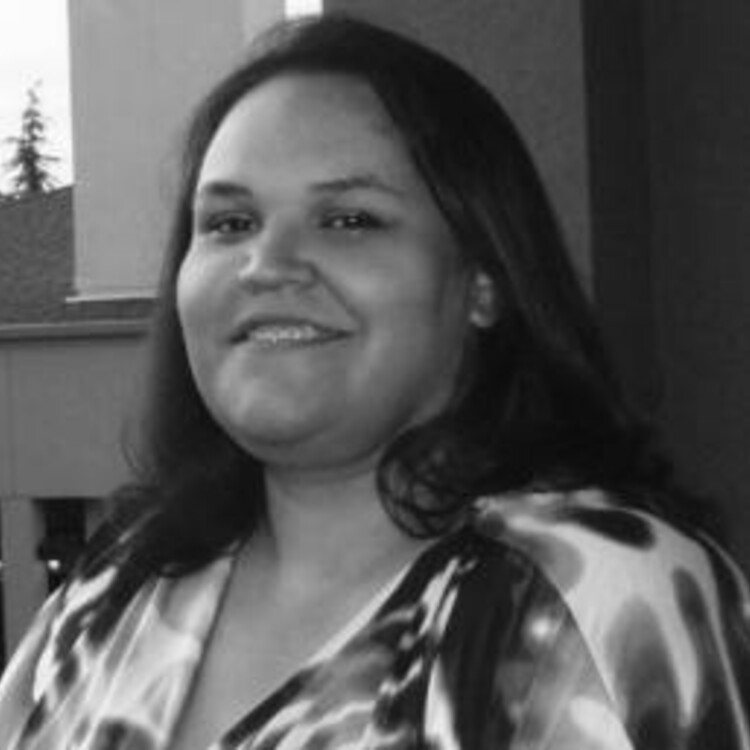



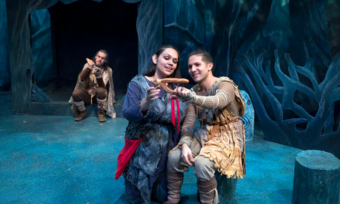
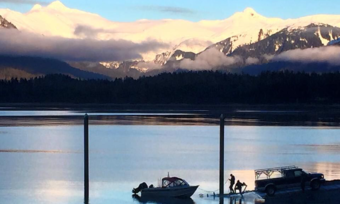
Comments
The article is just the start of the conversation—we want to know what you think about this subject, too! HowlRound is a space for knowledge-sharing, and we welcome spirited, thoughtful, and on-topic dialogue. Find our full comments policy here
Thank you for this <3
Gunalcheesh for reading!
Beautiful. Gunalchéesh for holding up Nora Marks Dauenhauer (https://youtu.be/o6v3u_vamCM), Ed Littlefield, my friends at Perseverance, my adoptive family, and the Native arts and culture of Alaska.
Gunalcheesh Laurie! Nora was a beautiful artist.